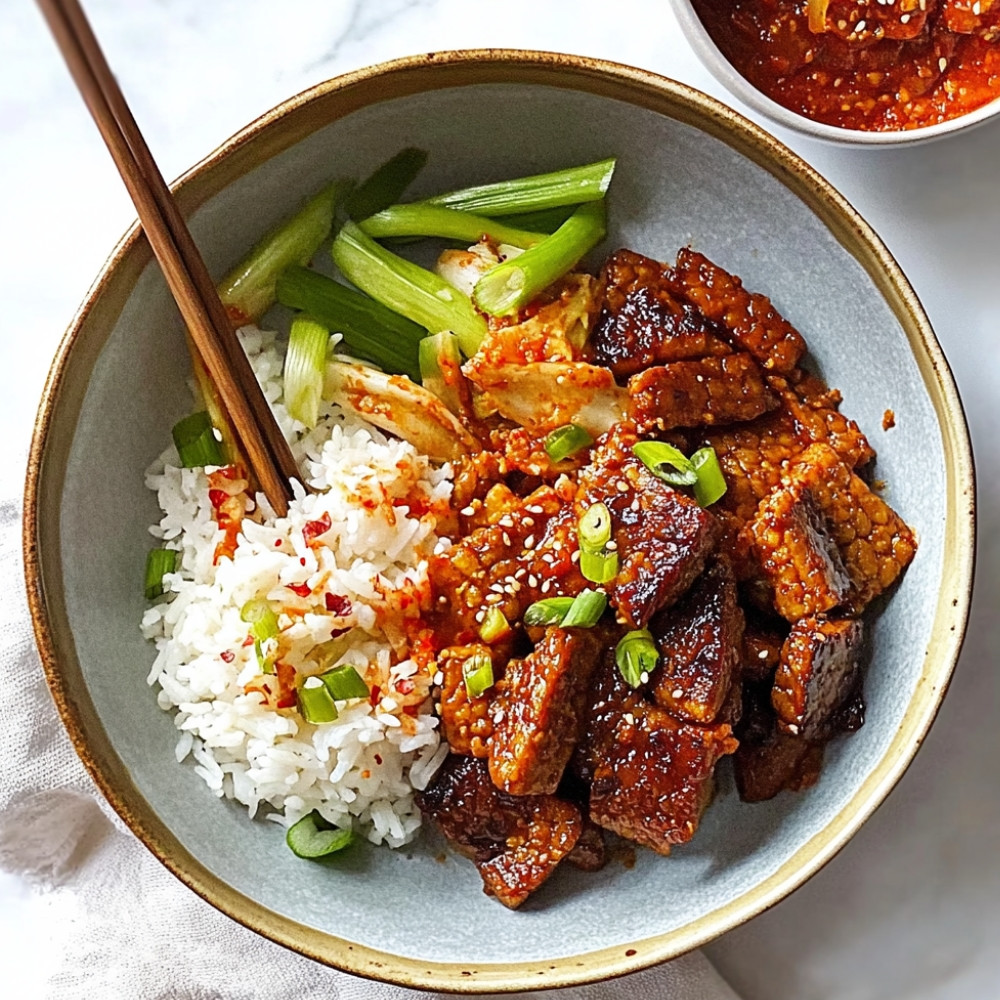Spicy Tempeh Bulgogi
The kitchen smelled like memory – warm soy, toasted sesame, something sharp from the vinegar curling in the air. And that slow hit of chili… not too loud but definitely confident. I stood there, wooden spoon in one hand, just watching the tempeh soak up everything, growing darker and glossier as each minute went by. It’s funny. Sometimes a dish doesn’t just feed you – it sits with you all evening, sneaks into your clothes, your thoughts. Spicy Tempeh Bulgogi does that. It fills a room, a pan, your plate—and it feels kind of like company.
Why You’ll Crave It
- Sweet, bitter, spicy, and umami all tangled perfectly – no one wins, they all shine.
- A forgiving recipe that doesn’t fuss about exact timing – nice for weeknights when you’re tired but still want dinner with soul.
- Tempeh’s nutty firmness soaks up the marinade like it wanted to wear it – never boring, never bland.
- Great hot, but leftovers somehow get better by the next day? (Edgy and mellow, all at once.)
- It’s vegan – but not in a “missing something” way. Nothing’s missing. It’s all just… here.
The first time I made this, I had to stop halfway through and write the marinade down—I didn’t want to forget it. It felt like a little kitchen miracle.
What You’ll Need
- Tempeh (1 block, about 8 ounces): earthy and a little nutty, slice it thin to draw in all the flavor.
- Soy sauce (1 tbsp): salty, deeply savory—just the classic kind is perfect here.
- Gochujang (1 tbsp): thick, spicy-sweet Korean chili paste that brings real depth (not just heat).
- Sesame oil (1 tbsp): richly toasted, it smells like warmth.
- Rice vinegar (1 tbsp): adds a subtle brightness, prevents the sauce from feeling heavy.
- Maple syrup (1 tbsp): soft sweetness that smooths out the spice without dulling it.
- Garlic (2 cloves, minced): not shy – brings bite and aroma.
- Ginger (1 tsp, finely minced): slightly bold, adds something fresh and lifting.
- Vegetable oil (1 tbsp): for cooking – something neutral and high-heat-safe.
- Green onion (1, thinly sliced): sharp and fresh—we scatter this on top like punctuation.
- Sesame seeds: just a sprinkle for texture and that final little nutty crunch.
Easy How-To
Slice and Steam the Tempeh
Cut the block of tempeh into thin strips—it should feel sturdy, not too crumbly. I usually steam it for about 10 minutes beforehand, which softens the bitterness and helps it soak the marinade better. (You can totally skip this if you like tempeh more on the bold side.)
Whisk the Marinade
In a medium bowl, mix together the soy sauce, gochujang, sesame oil, rice vinegar, maple syrup, garlic, and ginger. Stir until it all comes together into a paste-like sauce. Smell it—just for a second. It should already feel like something warming.
Let the Tempeh Swim
Drop the sliced tempeh into the bowl and gently stir it around until the pieces are coated. Let them marinate for at least 30 minutes—longer if you’ve got time. Give it a little toss every so often so nothing settles.
Sizzle it Up
Add the vegetable oil to a skillet, heat it over medium-high. Once it shimmers a bit, lay down the tempeh in a single layer. Let it cook, no need to move it too fast. After 3–4 minutes a side, it’ll darken, the sugars from the maple and gochujang getting stretchy and caramel-ish along the edges.
Optional: Toss in Veggies
If you’re adding bell peppers or onions (I often do), throw them in during the last 3-5 minutes. Let them soften but still stay a little crisp—it gives the dish a nice play between tender and crunchy.
Plate and Finish
Scoop onto steamed rice or tuck into crisp lettuce cups. Scatter green onion over the top, then a few sesame seeds for sparkle. Eat right away… or nibble at it distractedly while standing near the stove (guilty of that).
Good to Know
- The marinade stains. Don’t wear anything white if you’re the enthusiastic-stirring type, like me.
- Tempeh sometimes smells a little odd out of the package – that’s normal. It settles down once cooked.
- This dish actually loves being cold. Next-day tempeh in a wrap with greens is some kind of secret lunch magic.
Serving Ideas
- Serve over jasmine or sticky rice with a small bowl of pickled cucumbers on the side.
- Fold into a warm tortilla with shredded cabbage and a swipe of vegan mayo (try this, really).
- Layer into a bibimbap-style bowl with spinach, a soft tofu wedge, and chili oil.
Top Tricks
- If you’re short on time, microwave the tempeh for 1 minute before marinating – it opens the pores a little.
- Sear the tempeh undisturbed for that crispy crust. Don’t flip too early. Let it catch color first.
- Taste your gochujang before using! Some brands are much spicier—or sweeter—than others.
Frequently Asked Questions
Can I use tofu instead of tempeh?
Absolutely. Just press it first so it doesn’t get soggy. The marinade still clings beautifully to tofu, though the result will be softer, more tender than chewy. Slightly different, still beautiful.
Do I really need to marinate it?
Technically you can skip it if truly rushed, but I wouldn’t. Even 15–20 minutes makes a big difference. It sets the flavor deep into the tempeh rather than just sitting on the surface.
It turned out too spicy—help?
Serve it with creamy coconut rice or even a little plain yogurt on the side if you’re not fully vegan. Cooling sides are your friend here. Next time, just ease up on the gochujang a little.
Can I double the recipe?
Yes – just make sure you cook the tempeh in batches. Crowd the pan and you lose the beautiful crisp edges.
How long will leftovers last?
Around 3 days, refrigerated in an airtight container. Honestly, it might taste better the next day—just reheat in a pan so it crisps up again a bit.







